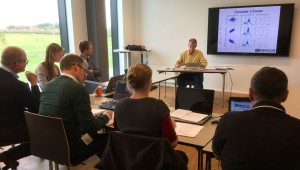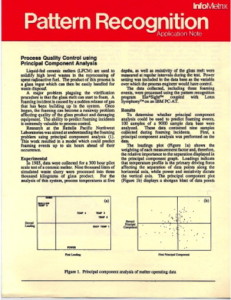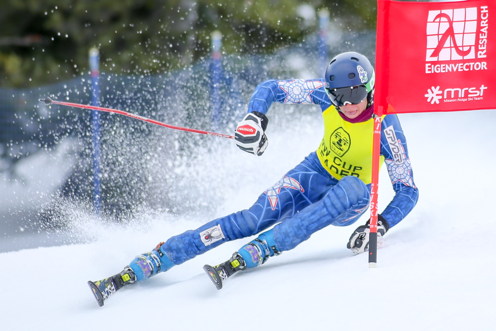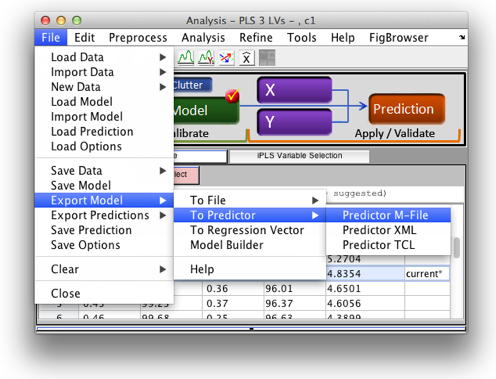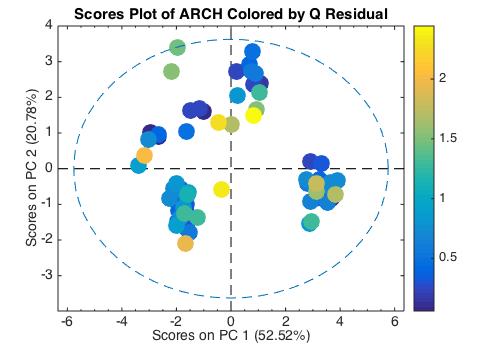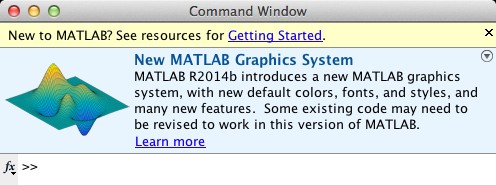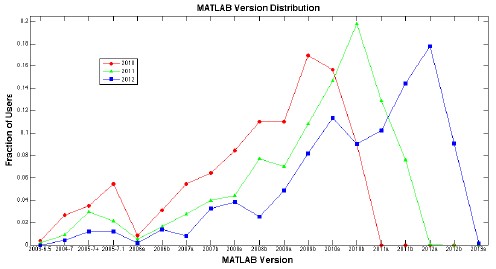Category Archives: Eigenvector News
Eigenvector at Chimiométrie XVII in Namur
Feb 4, 2016
Last month I had the pleasure of attending Chimiométrie XVII. This installment ran from January 17-20 in the beautiful city of Namur, BELGIUM. The conference was largely in French but with many talks and posters in English. (My French is just good enough that I can get the gist of most of the French talks if the speakers put enough text on their slides!) There were many good talks and posters demonstrating a lot of chemometric activity in the French speaking world.
I was pleased to see evidence of EVRI software in many presentations and posters. I particularly enjoyed “An NIRS Prediction Engine for Discrimination of Animal Feed Ingredients” by Aitziber Miguel Oyarbide working with the folks at AUNIR. This presentation was done with Prezi which I find quite refreshing. I also enjoyed posters about standardization in milk analysis, determination of post mortem interval, evaluation of pesticide coating on cereal seeds, and sorting of archeological material. All of these researchers used PLS_Toolbox, MIA_Toolbox or Solo to good effect.
EVRI was also proud to sponsor the poster contest which was won by Juan Antonio Fernández Pierna et al. with “Chemometrics and Vibrational Spectroscopy for the Detection of Melamine Levels in Milk.” For his efforts Juan received licenses for PLS_Toolbox and MIA_Toolbox. Congratulations! We wish him continued success in his chemometric endeavors!
Finally I’d like to thank the organizing committee, headed by Pierre Dardenne of Le Centre wallon de Recherches agronomiques. The scientific content was excellent and, oh my, the food was fantastic! I’m already looking forward to the next one!
BMW
Another EigenU Europe Complete
Oct 9, 2015
The Fifth Eigenvector University Europe ran October 5-8 at the FOSS Innovation Centre in Hillerød, Denmark. Rasmus Bro and I really enjoyed the group. Everybody came well prepared (MATLAB and PLS_Toolbox installed and tested!) and loaded with questions. We covered basic chemometrics then moved on to more advanced topics.
Many thanks to the kind folks at FOSS, especially Lars Nørgaard, for use of the venue. The Innovation Centre is a beautiful facility. The coffee and snack service is great and I love lunches in the cafeteria!
Chemometrics, of course, is critical to FOSS’ success. At the heart of many of FOSS’ user-friendly application specific analyzers lies a very sophisticated calibration model. Lars leads what is possibly the largest chemometrics group in the world with a staff of about 30. We appreciate their support of the field!
We’re already starting to think about EigenU Europe for fall of 2016. We’d like to move south next year and are considering Italy, Spain or southern France. If you’ve got an idea for a venue write to me with details.
Good job class, and thanks for coming!
BMW
30 Years of Chemometrics
Sep 30, 2015
On October 1, 1985 I walked into Bruce Kowalski’s chemometrics class and my world changed forever. It was my first day of chemical engineering graduate school at the University of Washington. My M.S. thesis advisor, Prof. Harold Hager, told me that I’d probably find the methods in Bruce’s class useful in treating the data I was to collect. He was right, but more than that, it wasn’t long before I knew that I’d found something I wanted to do for a living.
A big part of the class was a project, due at the end of the semester in early December. I spent my Thanksgiving vacation working with Infometrix’s Ein*Sight software doing PCA on data from a Liquid-Fed Ceramic Melter I’d worked on at Pacific Northwest National Laboratory. Ein*Sight had a limit of 100 samples and 10 variables but it ran on an IBM AT. I spent a lot of time swapping interesting samples in and out of the analysis and trying to interpret the results. I got an A on the project (Bruce gave lots of A’s!) and my study became a piece of Infometrix sales literature (left). From there I started working with Prof. Larry Ricker on my ChemE Ph.D. with Bruce on my committee. The rest, as they say, is history.
I always liked data analysis. As an undergrad in ChemE my lab partners referred to me as the “Data Magician.” I just liked massaging the numbers to see what I could tease out. Chemometrics gave me a whole new set of tools and opened my world up to high dimension data.
Chemometrics has taken me lots of interesting places over the last 30 years, and I mean that both with regards to the travel and the intellectual challenges. And I’ve been blessed to meet lots of great people. It’s awesome to go to a conference in a faraway place and walk into a room full of friends.
Thanks to all my friends and colleagues for a great 30 year adventure! But, man!, that was fast! Where did the time go? But I’m looking forward to a couple more decades of chemometrics escapades.
BMW
EigenU 2015 Poster Contest Winners
May 23, 2015
Like its predecessors, the 10th Annual Eigenvector University included the Tuesday evening PLS_Toolbox/Solo User poster session. Eight posters, which spanned a wide range of applications, were scrutinized by about 40 attendees. A good time was had by presenters and viewers alike as we enjoyed hors d’oeuvres, beverages and scientific discussion.
Amanda Lines of Pacific Northwest National Laboratory (PNNL) captured this year’s top prize with “Remote Raman technology for in-situ identification of nuclear tank waste.” The poster revealed how Raman spectroscopy combined with multivariate calibration can be used to analyze surfaces at distances up to 50 feet. Ms. Lines is shown below with her poster and EVRI Vice-President Neal B. Gallagher.
In a very close contest the runner up Anna Klimkiewicz of the University of Copenhagen presented “A chemometric approach to the optimization of bio-industrial processes.” The work illustrated the application of multivariate analysis to understand and improve performance in an industrial-scale continuous enzyme purification process. Ms. Klimkiewicz can be seen with her poster (and me) below.
Both of these posters clearly presented an interesting story and made especially good use of our PLS_Toolbox. As a reward for their efforts Amanda took home a pair of Bose Noise Canceling Headphones while Anna took home a Bose Bluetooth Speaker system. Well deserved! 👍 We hope you enjoy them.
Thanks to everybody who attended and presented at EigenU!
BMW
MRST Shines at Eigenvector Research NW Cup Finals
Apr 19, 2015
The 2014-15 ski season wrapped up at Mission Ridge on April 9-12 with the Eigenvector Research NW Cup Finals. It was a great four days which included two days of Giant Slalom (GS) races and two days of Slalom (SL) races, plus a bonus Dual Slalom on the final afternoon. Mission Ridge Ski Team (MRST) athletes had an awesome weekend winning 8 out of the 10 races along with many other podium finishes. Victories were captured by Lindsey Ahmann (GS1, SL1), Hannah Bodily (GS2, SL2 and the Dual SL) and Brian Davidson (GS1, GS2 and the Dual SL). There were also numerous other podium appearances including 2 each from Max Tobler and Gunnar Lundteigen. Plus Max Tobler, who also coaches young skiers for MRST, captured the overall NW Cup title based on his performance over the whole season. Max can be seen ripping up the Dual SL course. (Thanks to Brian Platt and SkiRacePhoto.com for the great shot!)
With all the possible things that a company might sponsor, why ski racing? Well, anybody who knows me very well knows that I just love skiing and ski racing in particular. Although I’ve skied since I was five, I got a late start at racing and really didn’t get serious about it until after I graduated from undergrad. I never got enough of it and still compete when I can squeeze it into the schedule. And of course we raised two ski racing daughters, with one still racing and one coaching, so we’ve had something of a vested interest.
But we’re happy to support ski racing because, like most sports, it is good for kids. The youngest kids learn to be on time, keep track of their gear, be good sports, work on their conditioning, etc. As they get older and more time and travel is involved, athletes learn time management so they can keep up their studies and get their ski prep work done in addition to the time they spend on the hill and in the gym. They learn about living with teammates and sharing work duties like meal prep and clean up. Plus it promotes an appreciation of nature and love of the outdoors.
But beyond that, ski racing combines speed, athleticism, skill and mental toughness like no other sport. Strength and conditioning are key, but they don’t guarantee success. To be fast, ski racers must learn techniques that at first seem awkward and, well, dangerous. Example: getting pressure on the new ski at the TOP of the turn. To do this requires skill and confidence. You have to believe it is going to work, and if you don’t believe it, it won’t. When they are in the start gate ski racers have to believe that they can execute their plan in spite of often sub-optimal course and weather conditions, all at 40+ mph.
In short, ski racing teaches a great work ethic and instills confidence. It turns good kids into great young adults. And that’s why Eigenvector is proud to sponsor the Mission Ridge Ski Team and NW Cup Finals.
BMW
Top Ten Reasons to come to EigenU 2015
Apr 1, 2015
If you are in the market for training in multivariate methods you have a number of choices. In North America, you could attend classes given by CAMO, ProSensus, or Umetrics. Here are 10 reasons you should come to the 10th Annual EigenU 2015, May 10-15 in Seattle, instead:
- More experienced instructors – Courses at EigenU 2015 will be led by the EVRI staff including Neal B. Gallagher, Jeremy M. Shaver, Robert T. Roginski, and Willem Windig, plus our Associate Rasmus Bro, and of course myself. Plus this year’s special guest Johan Westerhuis will lead the second edition of our Chemometrics in Metabolomics course. Together we’ve got over 100 man-years of chemometric experience.
- Wider variety of courses – In addition to our beginning track including PCA and PLS, we offer 11 advanced and specialty courses. This year we’re introducing three new courses: Hierarchical and Optimized Models, Multi-block, Multi-set, Multi-level and Data Fusion Methods, and Classical Least Squares Methods. Calibration Model Maintenance returns this year, as does the popular Bring Your Own Data (BYOD) Workshop where you work with your own data while you learn hands-on with EVRI’s team of instructors.
- Method-centric instruction – At EigenU we provide the background required to truly understand chemometric methods; we don’t just show you what buttons to push. Our goal is to make the literature in the field accessible to our graduates. Deeper understanding of the methods leads to better analysis!
- Beautiful Seattle, WA – With Puget Sound and the Olympics to the West and Lake Washington and the Cascades to the East, the Emerald City is distractingly scenic. Plus, it is home to the Space Needle, Pike Place Market, Seattle Art Museum, Seattle Mariners (home games May 8-10, & 12-15), the largest ferry system in the US, plus tons of other attractions.
- The Washington Athletic Club – EigenU is held at the WAC, the nation’s premier city athletic club. The historic 21 story facility includes 5 floors of fitness facilities, 10 floors of Euro-styled techno-centric sleeping rooms, full service spa, and 3 restaurants.
- The food – From the continental breakfast, including the WAC’s signature sticky buns, through the gourmet plated lunches, to afternoon snack bars, our guests always rave about the food.
- Networking – EigenU attendance is typically about 40 scientists and engineers with a range of chemometric expertise and wide variety of interests. This means you’ll have plenty of opportunity to find colleagues with common problems and complementary solutions.
- Evening events – EigenU provides ample opportunity to continue your chemometric learning and networking into the evening. This includes Tuesday’s PLS_Toolbox/Solo User Poster Session, Wednesday’s PowerUser Tips & Tricks Session, and Thursday’s Workshop Dinner, which is one more opportunity to enjoy the WAC’s fabulous food. Present a poster at the Tuesday evening User Session and you could win a pair of Bose Noise-cancelling Headphones or Bluetooth Wireless Speaker!
- Flexible, multi-platform software – With PLS_Toolbox and MIA_Toolbox EVRI offers the most comprehensive set of chemometric tools available plus the flexibility of MATLAB. Our stand-alone packages Solo and Solo+MIA offer all the point and click tools of their MATLAB-based siblings. Plus they’re all available for Windows, Linux and MacOS. On-line tools Solo_Predictor and Model_Exporter provide a plethora of options for automating model application.
- Costs less – In spite of all its advantages, EigenU actually costs less than similar courses from CAMO, Umetrics and ProSensus.
So it probably isn’t surprising that EigenU attendees are more than satisfied. Here’s what a couple of them had to say:
“I attended the Eigenvector University 2010 earlier this year. It was the best short-course I have ever taken on any subject. I highly recommend it if you’re looking for a short-course, immersion kind of training.” – James M. Roberts, GSK
“What you are offering here is unmatched.” – David A. Russell, Dupont.
Discount registration ends soon, register and pay by April 10 for the best prices.
See you at EigenU!
BMW
A Layperson’s Introduction to EVRI
Mar 18, 2015
This spring I was contacted by Holly Thorpe of the Wenatchee Valley Business World about doing a piece on Eigenvector. I was, of course, pleased to oblige! The timing was especially good as we celebrated our 20th Anniversary earlier this year. The resulting article captures the flavor of EVRI quite well, and is a great layperson’s introduction to the type of work we do.
Our thanks go to Holly for the article and photographer Don Seabrook for capturing my work environment. (My daughter commented that she had never seen my office that clean!) I really enjoyed the process–I always get really enthusiastic when I start talking about Eigenvector!
BMW
EigenU 2014 Poster Contest Winners
Mar 2, 2015
Each year, Tuesday evening at Eigenvector University features the PLS_Toolbox/Solo User Poster Session. Prizes are given for the two best posters as judged by the Eigenvector staff, associates, and guest instructors.
At EigenU 2014 there were 10 posters presented by users, plus a couple more from EVRI, which made for a very lively session. Associate Rasmus Bro and guest lecturer Age Smilde, (who was there to lead the “Chemometrics in Metabolomics” course), assisted the Eigenvectorians in choosing the best posters. The winners were Eric Massicotte of the Canada Border Services Agency (CBSA) and Sarah Nielsen of Janssen Supply Group.
Massicotte displayed “Determination of the Geographic Origin of Tobacco Leaves by NIR.” A Partial Least Squares Discriminant Analysis (PLS-DA) model based on the NIR spectra of flue-cured tobacco leaves was developed that classified the samples into the 10 countries of origin. The sensitivity and specificity of the model was found to be greater than 0.92 for all classes except the USA group, which has the largest variability. The technique may be used in the future as a screening tool by the CBSA.
Nielsen presented “Distribution Analysis of Components in the EVRA® Patch by Confocal Raman Microscopy” which she developed with her co-author Amber Mantz. Confocal Raman Microscopy (CRM) images were generated at various locations within EVRA® samples to charaterize drug product and excipient distributions. PLS models were developed to predict relative drug concentration in the patches. Samples were analyzed from time of manufacture to product expiry to determine if changes in drug concentrations occurred. The models indicated that there were no significant changes over the life of the product.
Nielsen and Massicotte each received an Apple iPod nanos engraved with Eigenvector University 2014 Best Poster for their efforts. Good work, and thanks to everybody that presented at EigenU 2014!
BMW
Chemometrics Consultant position opening at Eigenvector Research
Feb 25, 2015
Eigenvector Research, Inc. (EVRI) has an opening for a full time Chemometrics Consultant staff member. Applicants should have a M.S. or Ph.D. degree in Chemistry, Chemical Engineering, or a closely related field and at least five years experience developing chemometric models. Experience in the pharmaceutical, chemical, medical device, food and beverage or bioinformatics fields would be useful. Practical knowledge of analytical techniques, especially spectroscopy, required. Must be proficient in MATLAB. Experience with Javascript, HTML, CSS and other programming languages would be a plus. Experience with EVRI’s software, especially PLS_Toolbox and MIA_Toolbox, sought. Experience with other chemometrics packages also a plus. Teaching experience desired.
The successful candidate is expected to take a lead role on some chemometrics consulting projects and a supporting role on others. Must be able to meet with potential clients, understand their goals and needs, develop a statement of work, and execute the tasks. Good written and oral communications skills, especially the ability to convey complex information to non-experts, required. Potential to attract new projects through new and existing contacts preferred. Must be able to work at home. Location not critical but proximity to our existing locations would be a plus.
EVRI employees enjoy working on interesting projects with a dedicated, fun and lively team of chemometrics and programming experts. EVRI offers a competitive salary and benefits package, plus flexible hours and the ability to work at home.
Applicants should send a C.V. and letter of interest to Barry M. Wise.
Eigenvector Turns 20
Feb 19, 2015
Eigenvector Research, Inc. (aka EVRI) passed a significant milestone when we turned 20 years old on January 1, 2015. The event passed without a lot of fanfare around here. Frankly we were just all a little bit too busy to do much beyond offering a few internal congratulations!
Eigenvector was founded on January 1, 1995 when Neal Gallagher and I used our credit cards to buy computers and office furniture. Neal was living with us in West Richland, WA, and that became our first offices. Our original plan was that we would be primarily a consulting company and also continue to develop our MATLAB-based PLS_Toolbox. Our first two consulting projects were for Pacific Northwest National Laboratory (PNNL) where we had both been employed. The first involved development of models based on FTIR spectroscopy to estimate the organic gas content and ozone forming potential of automobile exhaust. The second was analysis of the behavior of waste tank SY-101, Hanford’s notorious “burping” tank.
We soon discovered that there was a significant demand for chemometrics courses. The field was relatively new and lots of companies wanted to take advantage of the possibilities that multivariate analysis opened up. I had taught a chemometrics course at the Joint Center for Graduate Study, (now Washington State University Tri-Cities), and was happy to take it on the road. Thus we became the three-legged stool that we are today, providing chemometric software, consulting and training.
In 2001 we made the first addition to our technical staff with Jeremy M. Shaver, now our Chief of Technology Development. This was possibly the best decision we’ve ever made. Under Jeremy’s stewardship PLS_Toolbox has developed into the user-friendly and comprehensive package that it is today. Plus we’ve added our stand-alone Solo, tools for Multivariate Image Analysis, and on-line predictor packages Solo_Predictor and Model_Exporter.
Our software sales have grown continuously for more than a decade and now comprise the largest third of our business. We now have 2500+ users in more than 1000 companies and universities across 50+ countries.
We joke sometimes that we founded EVRI because life is too short to drink bad beer, do boring work or live in a crappy place. But there’s an element of truth in that. We’ve gotten to work on some fascinating projects over the last 20 years. Some frustrating ones as well, but on average pretty interesting stuff. We’d like to think we’ve done some good in that we’ve trained a lot of chemometricians, provided tools that make their work easier, and advanced projects that have made processes more efficient and benefited consumers and patients.
We look forward to continued growth and more stimulating projects over the next 20 years!
BMW
Nonlinear Model Support Added to Model_Exporter
Oct 22, 2014
Model_Exporter is EVRI’s software for turning multivariate/chemometric models into formats which can be compiled into online applications. It offers an alternative to our stand-alone prediction engine Solo_Predictor. Model_Exporter allows users of our MATLAB® based PLS_Toolbox and stand-alone Solo to easily create a numerical recipes of their models. These recipes give the step by step procedure that take a measurement and calculate the desired outputs, such as concentration, class assignment, prediction diagnostics, etc. This includes applying all preprocessing steps along with the model (PCA, PLS, PLS-DA etc.) itself. When Model_Exporter is installed, models can be exported into predictor files in a variety of formats via the file menu in the Analysis window as shown below.
Model_Exporter also includes two versions of the freely-distributable Model_Interpreter. Either the C# or Java version of the Model_Interpreter can be used by any 3rd party program to add the ability to parse an exported model in XML format. Simply point the interpreter at an XML exported model and supply the data from which to make a prediction. The interpreter applies the model and returns the results. Model_Interpreter has no licensing fees and is appropriate for use on standard processors and operating systems or on handheld devices run by reduced instruction set processors (e.g. ARM). Your application doesn’t need to know anything about the preprocessing or model being used.
Version 3.0 of Model_Exporter was released in early October along with its associated stand-alone Solo+Model_Exporter version 7.9. This release includes support for Support Vector Machine (SVM) regression and classification models as well as Artificial Neural Network (ANN) regression models.
These changes represent a significant addition to Model_Exporter making it even more unique in the chemometrics world. No other chemometric modeling product offers anything as transparent, flexible or unencumbered by licensing. You can get more info about Model_Exporter by consulting the Release Notes and the Model_Exporter Wiki page.
Users with current maintenance can access these versions now from their account. If expired, maintenance can be renewed through the “Purchase” tab.
If you have any questions, feel free to write us at orders@eigenvector.com.
BMW
MATLAB R2014b and PLS_Toolbox 7.9
Oct 7, 2014
The MathWorks released MATLAB R2014b (version 8.4) last week, and right on its heels we released PLS_Toolbox 7.9. R2014b has a number of improvements that MATLAB and PLS_Toolbox users will appreciate, specifically with graphics. The new MATLAB is more aesthetically pleasing to the eye, easier for the Color Vision Deficiency (CVD) challenged, and smoother due to better anti-aliasing. An example is shown below where the new CVD-friendly Parula color map is used to indicated the Q-residual values of the samples.
But the most significant changes in R2014b are really for people (like us) that program in MATLAB. For instance, TMW didn’t just change the look of the graphics, they actually changed the entire handle graphics system to be object oriented. They also added routines useful in big data applications, and improved their handling of date and time data. When you start the new MATLAB the command window greets you with this:
“Some existing code may need to be revised to work in this version of MATLAB.” That is something of an understatement. In fact, R2014b required the update of almost every interface from PLS_Toolbox 7.8. Revising our code to work with R2014b required hundreds of hours. But the good news for our users is that we were ready with PLS_Toolbox 7.9 when R2014b was released AND, as always, we made our code work with previous versions of MATLAB (back to R2008a). This, of course, is the significant difference between a supported commercial product and freeware. Not only do you get new features regularly, but you can rely on it being supported as operating systems and platforms change.
So if you look at the Version 7.9 Release Notes, you won’t see a lot of major changes. Instead, we took the time to assure compatibility with R2014b and made many minor changes to improve usability and stability.
The new MATLAB will allow our command-line and scripting users to do their science more efficiently and present their result more elegantly. These improvements will benefit us as well, and will ultimately translate into continued improvement in PLS_Toolbox and Solo.
BMW
Eigenvector Starts 20th Year
Jan 6, 2014
On New Year’s day 2014 Eigenvector Research, Inc. (EVRI) celebrated its 19th birthday and began its 20th year. The momentum that carried us into 2013 built throughout the year and resulted in our largest year-over-year software sales increase since 2007. Our best three software sales months ever have all been within the last five months. Clearly our partnering with analytical instrument makers and software integrators plus our tools for putting models on-line are striking a responsive chord with users.
The consulting side of our business also continues to be very busy as we assist our clients to develop analytical methods in a wide variety of applications including medical, pharmaceutical, homeland security (threat detection), agriculture, food supplements, energy production and more.
The third leg of our business, chemometrics training, continued unabated as we taught on-site courses for government and industry, courses at conferences and held the 8th edition of our popular Eigenvector University (EigenU). We enter 2014 firing on all cylinders!
Major additions to PLS_Toolbox and Solo in 2013 included the Model Optimizer, Hierarchical Model Builder, a new Artificial Neural Network (ANN) tool, and several new file importers. We will soon release an additional ANN option along with new tools for instrument standardization/calibration transfer. Also on the horizon, a major new release of Solo_Predictor will include an enhanced web interface option and additional instrument control and scripting options.
2014 includes a busy schedule with conferences, talks, conference exhibits and short courses. Below is a listing of where you’ll be able to find us:
- January 21-24, IFPAC, Arlington, VA. BMW to present “Mixed Hierarchical Models for the Process Environment” and “A Multivariate Calibration Model Maintenance Road Map.”
- March 2-6, Pittcon Chicago, IL. NBG and RTR will be at the EVRI exhibition booth.
- April 27-May 2, EigenU 2014, 9th Annual Eigenvector University, Seattle, WA. Join the complete EVRI staff for 6 days of courses and events.
- May 6-9, EuroPACT, Barcelona, Spain. BMW to give plenary address “Model Maintenance: the Unrecognized Cost in PAT and QbD” and a condensed version of our “Chemometrics without Equations” short course.
- June 1-4, CMA4CH, Taormina, Italy. JMS to teach short course and talk TBD.
- June 8-12, CAC-XIV, Richmond, VA. NBG and RB to teach “Advanced Preprocessing for Spectroscopic Applications” and “Alternative Modeling Methods in Chemometrics.”
- August 2-8, IDRC, Chambersburg, PA. NBG to attend, talk TBD.
- September 14-18, ICRM, Nijmegen, The Netherlands. NBG to give keynote “An Overview of Hyperspectral Image Analysis in Chemometrics.”
- September 28-October 3, SciX 2014, Reno, NV. JMS Chemometrics Section Chair, talks and courses TBD.
- November 10-13, EigenU Europe, Hillerød, Denmark. Courses led by BMW and Eigenvector Associate Rasmus Bro.
- November 17-19, EAS 2014, Somerset, NJ. EVRI sponsor of Award for Achievements in Chemometrics. Courses and talks TBD.
We’re especially excited about this year’s Eigenvector University. This ninth edition of EigenU will include all our usual events (poster session, PowerUser Tips & Tricks, workshop dinner) plus five new short courses. Special guest Age Smilde will lead “Chemometrics in Metabolomics” and Rasmus Bro will present “Modeling Fluorescence EEM Data.” The other three new courses are “Calibration Model Maintenance,” “PLS_Toolbox Beyond the Interfaces” and “Getting PLS_Toolbox/Solo Models Online.” We expect EigenU 2014 to be an especially fun and fruitful learning experience.
We look forward to working with you in 2014!
BMW
Eigenvector Summit 2013
Aug 26, 2013
The Eigenvector staff is pretty spread out geographically. We have people in four cities in Washington, plus folks in Indiana and North Carolina. And then there’s our Associate Rasmus Bro in Denmark. So we don’t get together, other than virtually, very often. Generally we’re only together at Eigenvector University each spring in Seattle. But we’re so busy during that time that we don’t get to talk to each other much.
This July we remedied that by having our first ever Eigenvector Summit. We got together for a week in Manson on Lake Chelan where we discussed the future of Eigenvector’s efforts in software, training and consulting. Plus we had some great food and beverages, did a few tourist activities, visited some local hangouts, went out on the lake and, most importantly, enjoyed each other’s company.
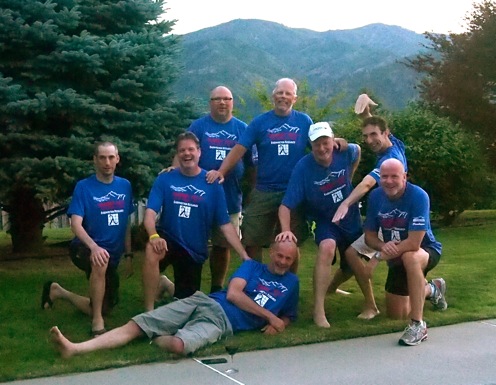
The EVRI developers are pictured above. Left to right are R. Scott Koch, Randy Bishop, Bob Roginski, Barry Wise, Donal O’Sullivan, Jeremy Shaver and Neal Gallagher with Rasmus Bro reclining. For a few more pictures from the Summit, see Scott’s slide show.
As is typical when we get together, we never ran out of things to talk about and try. The guys were often around the dining room table with their laptops writing demo code or pointing each other at new journal references. Other times we were out by the lake just brainstorming. (Thanks, Bob, for taking the notes!) And while I won’t reveal what we came up with, we expect that Eigenvector Summit 2013 will pay dividends for our users, students and clients in the years that come.
BMW
EigenU Poster Session: Apple iPad mini and iPod nano ordered
Apr 29, 2013
Each year at Eigenvector University we host a PLS_Toolbox/Solo User Poster Session and User Group Meeting. This is a fun event as it gives our users a chance to show what they have been doing with our tools. It is also a chance for them to relax, have a beverage, and give us input on upcoming versions of our software.
This year’s EigenU Poster Session will be Tuesday, May 14, at 6:00 at the Washington Athletic Club. PLS_Toolbox and Solo users will showcase their own chemometric achievements and share results and remaining problems with other users and the EigenU instructors. We’ll also have a brief User Group Meeting where attendees can see what’s in the future of Eigenvector software development and give their input and feature requests.
The poster session and user group meeting will include complimentary beverages and hors d’oevres. This year’s Best Poster grand-prize is an Apple iPad mini (32GB). The runner up will receive an Apple iPod nano. Judging will be done by the EVRI staff. Attendance at the poster session is free and open to all EigenU attendees and Eigenvector software users. You need not attend classes at EigenU to come!
If you would like to present your work, please send a title and brief abstract to bmw@Eigenvector.com. Please be sure to describe how PLS_Toolbox, Solo or our other software products were used in the work.
See you there!
BMW
Chemometrics Q&A at FOSS Video
Jan 28, 2013
We have developed a collaboration with FOSS where we teach an open chemometrics course at their World Headquarters in Hillerød, Denmark, each fall. During our last course, the FOSS folks asked if I would do an interview for their NIRPerformance.com website. The website is a resource for Feed industry professionals who work with Near Infrared (NIR) spectroscopy.
The interview is a little bit slanted towards NIR users but contains some good general information about our courses, consulting and general chemometrics philosophy. In the video I answer the following questions about chemometrics and our courses:
- Whom are your chemometrics courses for?
- How much of an NIR solution is based on chemometrics?
- What does the average NIR user need to know about chemometrics?
- What are the trends in chemometrics today?
- How will your course attendees use their training in chemometrics?
Our next big training event is Eigenvector University 2013. This 8th Annual EigenU runs May 12-17 in Seattle. We have a number of other training opportunities in 2013, including courses in the UK, Spain and France. See our schedule for details. We also plan to be back at FOSS for EigenU Europe this October.
BMW
MATLAB Version Distribution
Jan 24, 2013
One of the challenges of writing software that works with MATLAB is accommodating an array of versions. For better or worse, not everybody updates their MATLAB regularly. So we have to make our PLS_Toolbox and other toolboxes work with a fairly wide distribution of MATLABs.
To give you some idea of what our developers are up against, the plot below shows the distribution of MATLAB versions among our users for each of the last three years. (Click on the plot to get a much larger .pdf version.)
While the most common version in use at any one time tends to be one of the latest two or three releases, it never peaks at more than 20% of our users. And there are LOTS of users with older versions of MATLAB. Note that the plot goes back ten years to 2003! In 2010, we still had 12% of our users with MATLAB versions from 2005 or earlier. It was only after that dropped to less than 5% that we stopped supporting MATLAB 6.5 and 7.0.1 in our new releases. As shown in our release notes, we currently support MATLAB 7.0.4 (from early 2005) through the current MATLAB 8.0 (R2012b). And with our latest minor update (PLS_Toolbox 7.0.3) we’re ready for R2013a, so you’ll be set when it comes out.
But it is a balancing act. We don’t want to force users to upgrade their MATLAB. We understand that an older version of MATLAB works perfectly well for many users. But often we can’t take advantage of newer MATLAB features until we cut old versions loose. As an example, it would be much easier for our developers to use the newer format for coding objects (such as our DataSet Object) that became available in MATLAB 2008a. Until recently, however, 10% of our users were still working with MATLAB 2007b or older.
Our Chief of Technology Development Jeremy M. Shaver notes: Moving users to later versions of MATLAB allows us to utilize better graphical interface tools (making our interfaces easier to use and more powerful), modern hardware architecture (allowing faster processing and better memory management), and other new programming functionality (making the code easier for us to support and for our power-users to understand). Plus, having fewer MATLAB versions to support means we have fewer “special cases” to support in the code. We balance this against our user’s inconvenience and cost in order to achieve the best overall result for our customers!
Well said, Jeremy!
BMW
2012 Another Good Year for EVRI, on to 2013!
Jan 16, 2013
2012 is in the books and it was another good year for EVRI. Once again our year-over-year software sales were up. The end of the year was especially good. November was our best software sales month ever until December, which was better still! We move into 2013, our 19th year, with a renewed sense of momentum.
In 2013 we’ll continue to build on the unique features of our software. As always, improvements and additions are driven by the combination of customer requests, our own needs for consulting projects, and interesting developments in the field of chemometrics. We will continue to release two major updates a year (spring and fall) and minor updates as required. Updates are free to users with active maintenance agreements. Software support continues to be a top priority, and we have extended the hours of coverage for our e-mail based HelpDesk@Eigenvector.com, now 6am to midnight Eastern Time, Monday-Friday, (with additional checks on weekends).
Software improvements planned for 2013 include:
- Methods to help automate the model building process in PLS_Toolbox and Solo
- Automatic evaluation of different model types and preprocessing schemes
- Improvements to Solo_Predictor for on-line analysis, including expansion of the number of ways to communicate with other software and instruments
- Compatibility with more instruments from more manufacturers, more Technology Partners
Our training efforts will continue unabated in 2013, with our 8th annual Eigenvector University planned for May 12-17. You’ll also find our courses at numerous conference sites. Our EigenU Online classes will be expanded, with classes on Clustering and Classification and Multivariate Image Analysis coming this Spring. And of course we’ll continue to add to our bank of EigenGuide Videos demonstrating use of our software.
EVRI’s staff of consultants and software developers, with a combined 100+ man-years of chemometrics experience, will continue assisting clients both domestically and internationally.
We look forward to working with you in 2013!
BMW
Bruce Kowalski
Dec 3, 2012
I was sitting in a cubicle in the United Club at Chicago O’Hare when I learned of Bruce Kowalski’s passing. The news was not unexpected, but it was still tough, in part due to my whereabouts in a busy place but with no friends or family. Additional memories factored in: I had also been in a United Club cubical when I heard of my father’s death. But this was especially ironic because Bruce was the reason I was there in the first place, on my way to Lille for ChemomeTRIcS in Time-Resolved and Imaging Spectroscopy.
I met Bruce on what turned out to be the most pivotal day of my life, October 1, 1985. My existence divides between everything that came before that day and everything that came after. It was my first day of graduate school, the day I started learning about chemometrics, and also the day I met my friend and business partner Neal Gallagher. Bruce introduced me to the discipline that I became immediately enamored with and have spent my working life on. Bruce also introduced me to his then Post-Doc Dave Veltkamp and his wife Diane who in turn introduced me to my wife, Jill. This accounts for pretty much everything else in my present life.
An “idea guy” who’s enthusiasm was infectious, Bruce’s achievements include co-founding, with Svante Wold, the field of chemometrics, and co-founding, with Jim Callis, the Center for Process Analytical Chemistry. The full breadth of Kowalski’s influence is really too big to capture in this small space and couldn’t be done without substantial research. But as an example of his influence in one area I submit a graphic prepared by Pieter Kroonenberg and presented at TRICAP 2000. The “Kowalski Web” demonstrates that, for the field of Multi-way Analyisis in Chemistry and as far as it has become connected to Multi-way Analysis in Psychology, all the connections lead to Bruce, the center of the web. If this graphic were updated today Bruce would still be at the center, but it would be much larger!

I could go on and on about Bruce’s influence. At least two software companies exist today because of him, Infometrix and Eigenvector. Chemometrics has enabled the development of countless sensor systems and greatly expanded applications of spectroscopy, especially NIR. The methodologies promoted by Bruce have become so pervasive that quantifying their impact would be a very large exercise.
Bruce taught me lots of things, both chemometricly and otherwise. The chemometric stuff is (I hope) obvious, so I’ll let that speak for itself. Beyond that, though, Bruce taught me to think big, that a good idea can’t be stopped, that it is important what you name things, to be magnanimous, and to spread the credit around. Bruce was always really good at talking up the people that worked for him. He found the best in people, let them know it, and then let other people know about it too. I’ve benefited greatly from that, as have many others. I hope that I’m as good with my staff as Bruce always was with his. And I strive to be as forward-looking, positive and fun to be around.
Farewell, Bruce. A little bit of you will live on in each of very many of us. You will remain in our thoughts and prayers.
BMW
Find Jeremy Shaver at EAS Next Week
Nov 8, 2012
Eigenvector’s Chief of Technology Development Dr. Jeremy Shaver is getting ready to head off to the Eastern Analytical Symposium (EAS). He’ll be busy on Sunday and Monday assisting Eigenvector Associate Dr. Don Dahlberg with Chemometrics without Equations (CWE). As I wrote previously, this year the popular CWE is being extended by a day to cover advanced data preprocessing. Jeremy will be demonstrating the methods using the recently released PLS_Toolbox/Solo 7.0. If you’d like to attend, there is still time to register through the conference web site!
Jeremy will also represent EVRI at the session honoring Professor Dr. Lutgarde Buydens of Radboud University Nijmegen for Outstanding Achievements in Chemometrics. The award is, once again, sponsored by Eigenvector Research. The award session, chaired by University of Barcelona’s Dr. Anna de Juan, will start Monday morning at 9:00am.
You might also find Dr. Shaver at the Cobalt Light Systems Ltd booth. Cobalt, one of EVRI’s Technology Partners, develops tools for non-invasive analysis. Their TRS100 pharmaceutical analysis instrument utilizes our Solo software for chemometric modeling. Jeremy will be there to advise users on how to best calibrate the system for their particular needs.
Of course, if you can catch him, Jeremy would be happy to talk to anyone interested in EVRI’s software offerings! He’s the Eigenvectorian most intimately familiar with our products and their features and capabilities. Drop Dr. Shaver an email if you’d like to meet him at EAS.
Have a good week!
BMW

 SEARCH
SEARCH